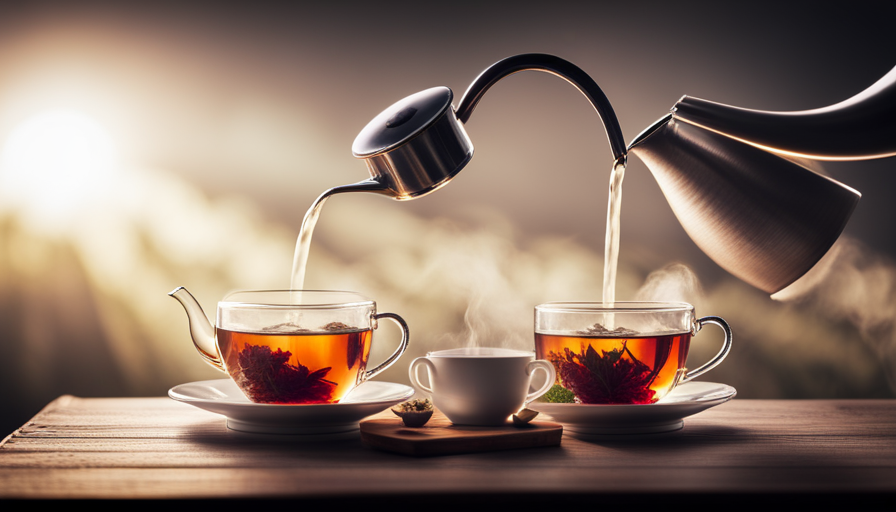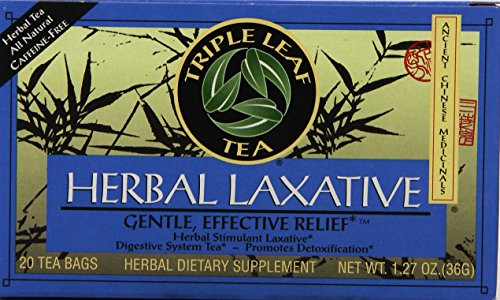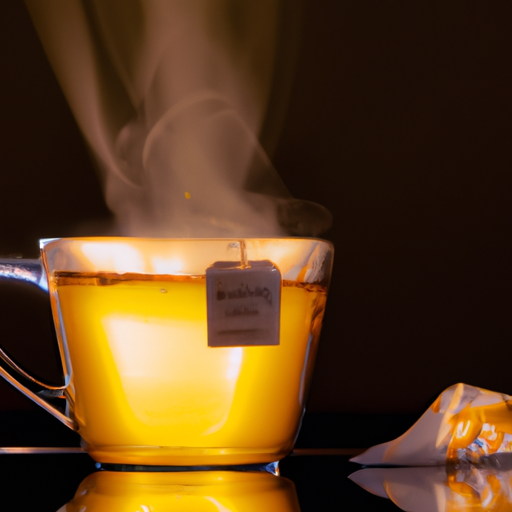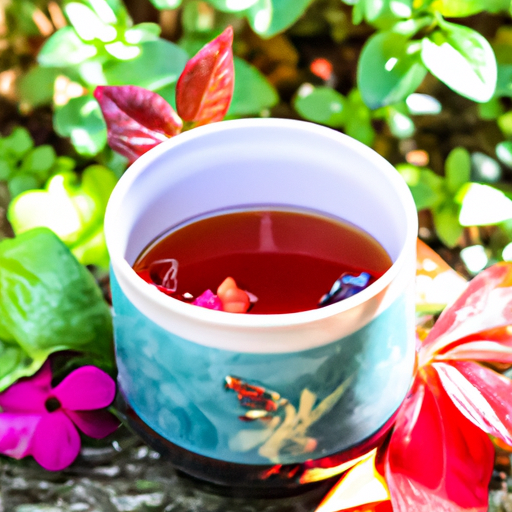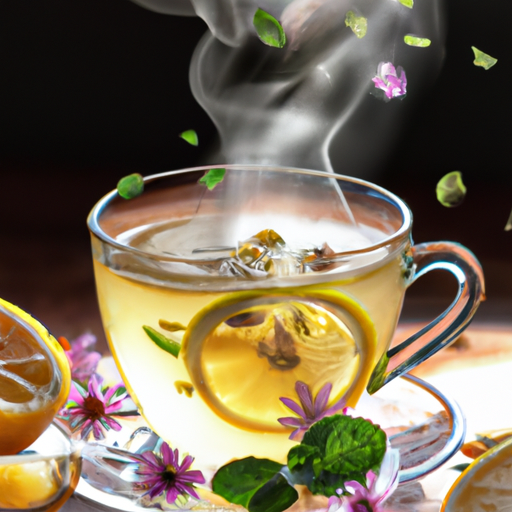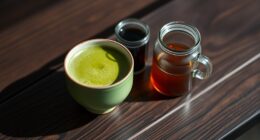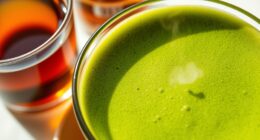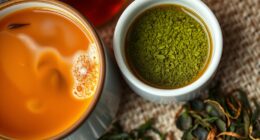I recall my initial experience brewing a cup of herbal tea. I meticulously measured the leaves, added hot water, and waited with anticipation for the flavors to develop. Upon taking a sip, I was let down by the weak and bland taste, far from the robustness I had anticipated. It dawned on me the crucial role water temperature plays in brewing herbal tea.
Just like a symphony conductor who carefully adjusts the tempo to bring out the best in each instrument, the temperature of the water plays a vital role in extracting the full potential of herbal teas. Each type of herbal tea requires a specific temperature range to unlock its unique flavors and health benefits.
In this article, I will guide you through the different types of herbal teas and the optimal water temperature for brewing each one. We will explore the benefits of using a thermometer or kettle with temperature control, as well as how to adjust the temperature to suit your personal preferences.
So, grab your favorite mug and let’s dive into the world of herbal tea brewing temperatures.
Key Takeaways
- Different types of herbal tea require specific water temperature ranges for optimal brewing.
- Using a thermometer or kettle with temperature control ensures accuracy and consistency in brewing herbal tea.
- Adjusting the brewing temperature can customize the tea experience based on personal preference.
- Temperature control preserves the delicate medicinal properties and flavors of herbs in herbal tea.
Understanding the Different Types of Herbal Tea
Do you want to know the key to unlocking the full potential of your herbal tea? Let’s dive into understanding the different types of herbal tea!
When it comes to brewing techniques, herbal teas can be classified into various categories based on the plant they’re derived from. Each type of herbal tea has its own unique flavor profile and health benefits.
One common type of herbal tea is chamomile, which is known for its soothing properties and ability to promote relaxation. Another popular herbal tea is peppermint, which has a refreshing and invigorating taste. It’s often consumed to alleviate digestive issues and relieve headaches. Additionally, there are herbal teas such as ginger, which is known for its anti-inflammatory properties and can help with nausea and digestion.
Knowing the different types of herbal tea is important because each type requires a specific brewing technique. Some herbal teas, like chamomile, are best brewed with boiling water, while others, like green tea, require water that’s slightly below boiling point. The temperature of the water can greatly affect the flavor and health benefits of the tea.
Understanding the different types of herbal tea and their respective brewing techniques is essential for achieving the best possible cup of tea.
Now, let’s explore the importance of water temperature in herbal tea brewing.
Importance of Water Temperature in Herbal Tea Brewing
Using the right amount of heat is crucial for extracting the full flavor and benefits from your favorite herbal infusion. When it comes to brewing herbal tea, the water temperature plays a vital role in achieving the perfect cup.
Here are some key points to consider:
-
Water temperature for green tea: Green herbal teas, such as mint or chamomile, should be brewed with water that’s around 175°F (80°C). This temperature allows the delicate flavors to develop without becoming bitter or overpowering.
-
Benefits of using filtered water: Using filtered water in your tea brewing process can greatly enhance the taste and quality of your herbal infusion. Filtered water removes impurities and chlorine, resulting in a cleaner and more refreshing cup of tea.
In addition to these points, it’s important to note that different herbal teas may require different water temperatures for optimal brewing. Some teas may benefit from slightly higher temperatures, while others may be best brewed at lower temperatures. These variations in temperature allow for the unique characteristics of each herbal tea to shine through.
Transitioning into the subsequent section about general guidelines for herbal tea brewing temperatures, it’s essential to understand the specific requirements for each type of tea to ensure the best possible taste and experience.
General Guidelines for Herbal Tea Brewing Temperatures
Get ready to create the perfect cup of herbal infusion by following these general guidelines for brewing temperatures. The optimal water temperature plays a crucial role in extracting the flavors and health benefits from your herbal tea. Adjusting the brewing time alone may not be enough; you need to consider the right temperature as well.
Herbal teas are delicate and require lower temperatures compared to black or green teas. Most herbal teas should be brewed between 190 to 210 degrees Fahrenheit (88 to 99 degrees Celsius). This temperature range allows for proper extraction of the herbal properties without causing any bitterness.
However, it’s important to note that different herbal teas may have specific temperature preferences. For example, delicate herbs like chamomile and lavender are best steeped at around 190 degrees Fahrenheit (88 degrees Celsius), while heartier herbs like peppermint and ginger can withstand higher temperatures of 200 degrees Fahrenheit (93 degrees Celsius).
To ensure accuracy and consistency, using a thermometer or kettle with temperature control is highly recommended. This will eliminate any guesswork and ensure that your water is at the perfect temperature before steeping your herbal tea. With the right temperature, you can unlock the full potential of your herbal infusion and enjoy a truly satisfying cup.
Using a Thermometer or Kettle with Temperature Control
Equip yourself with a trusty thermometer or kettle with temperature control to effortlessly achieve the perfect brewing conditions for your soothing cup of herbal goodness. Here are four reasons why these tools are essential for herbal tea enthusiasts:
-
Thermometer accuracy: Using a thermometer ensures that you have precise control over the water temperature. Different herbal teas require specific temperatures to extract the optimal flavor and medicinal properties. With a thermometer, you can be confident that you’re brewing your tea at the right temperature every time.
-
Consistency: A kettle with temperature control allows you to consistently brew your herbal tea at the desired temperature. This consistency ensures that you get the same delicious cup of tea with each brew, eliminating any guesswork or trial and error.
-
Enhanced flavor: By accurately controlling the water temperature, you can bring out the best flavors in your herbal tea. Steeping at the recommended temperature helps extract the delicate nuances and subtleties of the herbs, resulting in a more flavorful and enjoyable cup of tea.
-
Preservation of herbal properties: Different herbal teas have varying heat sensitivities. Using a temperature-controlled kettle prevents overheating, preserving the delicate medicinal properties and ensuring that you can reap the full benefits of the herbs.
With your thermometer or temperature control kettle in hand, you’re now ready to adjust the brewing temperature based on your personal preference, as we’ll discuss in the next section.
Adjusting Temperature Based on Personal Preference
To customize your tea experience, you can tailor the heat level, allowing you to savor the flavors and aromas that suit your taste buds, like a master chef adjusting the flame on a stove. Adjusting the temperature when brewing herbal tea is a simple yet effective way to enhance your tea-drinking pleasure. By experimenting with different teas and adjusting the brewing time, you can find the perfect balance that suits your preferences.
One way to adjust the temperature is by using a thermometer or kettle with temperature control. This ensures that your tea is brewed at the optimal temperature, as different herbs require different heat levels to extract their full flavor. For example, delicate herbs like chamomile and lavender should be brewed at a lower temperature, around 180°F (82°C), while robust herbs like peppermint and ginger can withstand higher temperatures, around 200°F (93°C).
Another method is to adjust the temperature based on personal preference. If you prefer a stronger flavor, you can increase the temperature slightly and extend the brewing time. Conversely, if you prefer a milder taste, you can lower the temperature and shorten the brewing time. It’s all about finding the balance that brings out the best in your chosen herbal tea.
By adjusting the temperature to your liking, you can truly create a tea experience that is tailored to your taste. As we delve into the subsequent section about steeping time and temperature for maximum flavor, you will discover more ways to elevate your tea enjoyment.
Steeping Time and Temperature for Maximum Flavor
Indulge in the tantalizing dance of flavors and unlock the full potential of your favorite brew by mastering the art of steeping time and the perfect infusion. When it comes to herbal tea, experimenting with infusion time can lead to stronger and more pronounced flavors. The longer you let the tea steep, the more intense the taste will be. However, be cautious not to go overboard, as steeping for too long can result in a bitter and unpleasant brew. It’s all about finding the right balance.
Temperature also plays a crucial role in extracting the maximum flavor and health benefits from your herbal tea. Different herbs have different optimal temperatures for brewing. Generally, a temperature range of 200°F to 212°F (93°C to 100°C) is suitable for most herbal teas. However, some delicate herbs, like chamomile or hibiscus, are better brewed at a lower temperature to preserve their delicate flavors.
It’s important to note that the temperature of the water can also affect the health benefits of herbal tea. Certain compounds in herbs are heat-sensitive and can be damaged by boiling water. To fully enjoy the medicinal properties of your herbal tea, steep it at a temperature that won’t compromise its healing properties.
By experimenting with infusion time and paying attention to the temperature, you can unlock a world of flavors and ensure you’re getting the most out of your herbal tea. So go ahead, explore the depths of taste and reap the benefits of a perfectly steeped cup of herbal goodness.
Frequently Asked Questions
Can I use the same water temperature for all types of herbal tea?
No, you can’t use the same water temperature for all types of herbal tea. Just like different brewing methods bring out unique flavors, different herbal teas require specific water temperatures to unlock their full potential.
It’s like a symphony of flavors waiting to be conducted. Some teas, like chamomile and peppermint, thrive in lower temperatures around 180°F, while others, like hibiscus or ginger, need a hotter brew at around 200°F.
So, varying water temperatures bring out the best in different herbal teas.
How long should I wait after boiling water to reach the optimal temperature for brewing herbal tea?
To properly steep herbal tea, it’s important to wait after boiling water to reach the optimal temperature. Different types of herbal tea require different brewing times. For example, chamomile tea should be steeped for 5-7 minutes, while mint tea only needs 2-3 minutes.
By allowing the water to cool slightly after boiling, you can ensure that the tea reaches the perfect temperature for extraction, resulting in a flavorful and aromatic cup of herbal tea.
Is it necessary to use a thermometer or kettle with temperature control for brewing herbal tea?
Using a thermometer or kettle with temperature control isn’t necessary for brewing herbal tea. In fact, simplicity is key! When it comes to temperature, hot water is better for brewing herbal tea as it helps extract the flavors effectively. As for the brewing methods, steeping the tea leaves or bags in hot water for 5-7 minutes is ideal. This allows the flavors to infuse perfectly, resulting in a delicious and soothing cup of herbal tea.
Can I adjust the brewing temperature based on the weather or season?
Yes, you can definitely adjust the brewing temperature of herbal tea based on the weather or season.
The temperature at which you brew your tea has a significant impact on its flavor. For example, during colder weather, you may want to use a slightly higher temperature to extract more flavor from the herbs. On the other hand, during warmer seasons, a slightly lower temperature can help preserve the delicate flavors of the herbs.
Adjusting the brewing temperature allows you to customize the taste of your herbal tea to your liking.
Does using different brewing temperatures affect the health benefits of herbal tea?
Using different brewing temperatures can indeed affect the health benefits of herbal tea. The temperature at which you brew the tea can alter the release of certain beneficial compounds, such as antioxidants and polyphenols.
Additionally, the taste of the tea can be influenced by the water temperature, with hotter water often resulting in a stronger, more robust flavor. Therefore, it’s important to consider the impact of brewing time and water temperature when seeking to maximize both the health benefits and taste of your herbal tea.
Conclusion
In conclusion, brewing herbal tea is an art that requires attention to detail. By understanding the different types of herbal tea and the importance of water temperature, you can create a delightful and flavorful brew.
Whether using a thermometer or a kettle with temperature control, adjusting the temperature based on personal preference is key. Remember, steeping time and temperature go hand in hand to maximize the flavor.
So, grab your favorite herbal tea, let the aroma fill the air, and indulge in a soothing cup of liquid tranquility.

